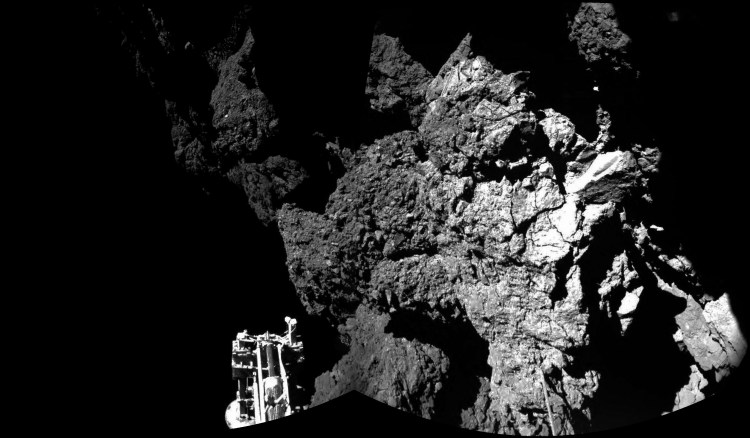The probe is perched on the surface of a comet more than 300 million miles away and sending pictures home. That’s the thrilling news about the decade-long Rosetta mission.
But in the jubilant hours after Wednesday’s touchdown, it became clear that the landing had been far from perfect. The bumps the Philae craft took along the way may turn out to be disastrous because it is not at the best landing site and it is not anchored.
The scientists at the European Space Agency’s mission control in Germany now know that the lander probably bounced when it reached its target landing site – maybe even over half a mile into the air, and just as far across the ground. “The lander may have lifted off (the comet) again … so maybe today we didn’t land once, we even landed twice,” Stephan Ulamec, the lander manager, said during a media update late Wednesday night.
Philae has already done some incredible things: The probe has sent home a panoramic shot of the comet’s terrain. It has begun analyzing the comet’s composition and is sending scientific data back to Earth. Its mission team is cautiously turning on more of its instruments in order of the degree of risk they pose to its position.
Comets, the Rosetta team has said, probably contain the elements that were present in the earliest days of the solar system, frozen in time. By digging into the mysterious ice, Philae is helping scientists learn more about the origins of the solar system and the planets.
But Philae may not last for its projected four-month run.
At a news conference Thursday, Ulamec announced that the probe had bounced not just once but twice. “We landed three times, so there is an inflation of landing somehow,” he joked.
All kidding aside, these jumps could end up being catastrophic. Because Philae has failed to settle upright and anchor itself, which it was supposed to do by firing harpoons into the comet, it might get jostled into a position it cannot right itself from – or it might even bounce right off into space.
The big question now is not just whether Philae can stand still; it is whether the part of the comet it is on is a good place to be. Based on the image that Philae sent back to Earth, the landing team thinks it might be at the edge of a deep crater – but the team isn’t sure.
“I can’t really tell you much more than what you interpret yourself from looking at these wonderful images,” Ulamec said.
One concern is that Philae’s solar panels are not getting enough light in the lander’s position. During the course of the comet’s rotation, which takes 12 hours, the panels are exposed to light only for about an hour and a half, instead of the seven hours they would have gotten at the optimal landing site. That is not nearly enough to keep Philae operational. The lander left Earth with only a 60-hour backup charge.
The mission team is working to get a better idea of the lander’s position, which could conceivably shift back to something more favorable on its own. The team could also try to figure out a way to reposition the probe, but with the batteries dying it may end up racing against the clock. And anything it does runs the risk of bouncing Philae into an even worse position, ruining the time that’s left.
Philae was never meant to be a long-term data collector. No matter what happens to it in the next few days, it has a life expectancy of only around four months. Rosetta scientists predict that in March, when the comet nears the sun, the surface will grow too hot for Philae’s systems to continue operating.
The Rosetta spacecraft will keep working – and following the comet – until at least December of next year. But the team had hoped Philae would have more than a few days to go digging through the comet’s molecular treasure trove. The scientists also had hoped that the probe would get to observe what changes the comet undergoes as it approaches the sun – a task that is now likely to fall solely to Rosetta.
During its statements to the media, the Rosetta team seemed fully prepared for the eventuality of Philae’s early death. And up in orbit, Rosetta is doing just fine.
“The situation with the orbiter is perfect,” Ignacio Tanco, deputy spacecraft operations manager, said during a Wednesday press update. “Rosetta is performing flawlessly.”
Send questions/comments to the editors.



Success. Please wait for the page to reload. If the page does not reload within 5 seconds, please refresh the page.
Enter your email and password to access comments.
Hi, to comment on stories you must . This profile is in addition to your subscription and website login.
Already have a commenting profile? .
Invalid username/password.
Please check your email to confirm and complete your registration.
Only subscribers are eligible to post comments. Please subscribe or login first for digital access. Here’s why.
Use the form below to reset your password. When you've submitted your account email, we will send an email with a reset code.